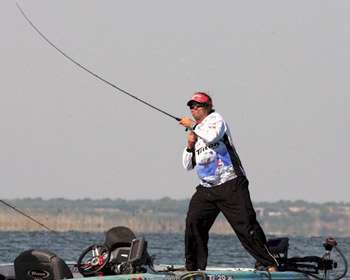
A few years ago, one of the best-kept secrets in the bass fishing industry was the concept of the swimbait. Everything changed four years ago at Amistad when the Elite Series visited the south Texas impoundment for the first time.
It was then that America was formally introduced to the swimbait, and anglers everywhere witnessed firsthand what it was capable of producing. Nowadays it seems that there are thousands of varieties of swimbaits to chose from that come in soft or hard plastic varieties and range in size from under 4 inches to longer than 13.
Elite Series pro Byron Velvick, a native Californian who now calls Del Rio, Texas, home, has long considered the swimbait (in all its variations) as his "go to" offering under the right conditions. The bait, he points out, can be intimidating for those who are unfamiliar with what to look for when making a size selection.
"The first thing I do on any lake that I go to is to find what the main forage is," he says. "For instance, at Clark's Hill it's blueback herring, which usually run around 5 inches in length. In Florida, it may be a golden shiner that is around 8 inches. I want the shape, size, and color of my swimbaits to be as close as possible to the main forage base these bass prefer."
Matching your swimbait to whatever bait is indigenous to the lake you're fishing is Step 1, according to Velvick. Step 2 is to identify the depth the bass are holding. "By using your electronics, you can see where the majority of the bass are set up within the water column," he explains.
"This is going to tell me if I need to be throwing a bait that has a fast fall, or one that stays closer to the surface. I'm going to know this before I make the first cast, and in those two steps, I've already narrowed down my bait selection to just a few choices."
Those "few choices" Velvick mentions may still contain a variety of bait types: hard plastic, soft plastic, or a combination of the two — each offering the angler a specific variation on the same general theme.
However, he points out he's more of a "soft plastic swimbait fisherman" as he feels that that bait style is a better tournament bait because it tends to give him a better hooking percentage. The key to that attribute is the way the soft plastic collapses around the hook.
Though he may have his preferences, Velvick is not afraid to mix things up under the right situations. "I throw the hard bait if I'm fishing something that's relatively shallow and I want to move the bait slowly, or even 'wake' it on top," he says.
"When I start getting into deeper situations, or if I want to fish faster in shallow water, I'm going to go with a soft plastic — and most likely one that is impregnated with lead to allow it to fall faster."
Velvick points out that a swimbait, if used properly, can have the same effectiveness of a time-honored crankbait. "It's like choosing between a Wiggle-Wart and a DD22," he suggests. Everyone has his own idea of what works better and when," he says.
"Swimbaits are no different, but you have to experiment with them to learn which one will work best under each situation. It really becomes just a personal preference at that point, but you have to keep in mind that a swimbait is typically a low-percentage bait. But when you get one, it's usually going to be a good one."




